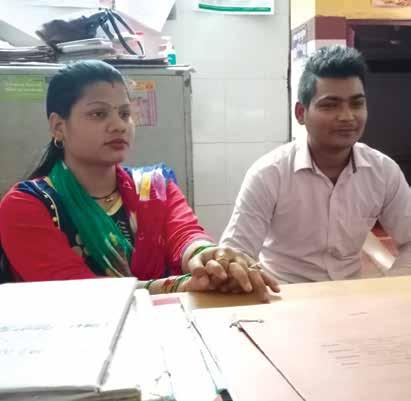
3 minute read
Gender Justice
from USPG Koinonia Issue 5 2/2021
by USPG
ISSUE 5 3/2021
By Kiran Bala, Delhi Brotherhood Society’s Womens‘ Helpline
Although the Indian mythologies have stories extolling and venerating women as heroic and as divinities, in actual practice the society is strongly hierarchical in two ways. The first is the caste hierarchy and the other is the patriarchy. It is easy to understand that caste hierarchy has the Brahman-priests on top followed by graded descending castes of Kshatriya-warriors, Vaishya-traders and Shudra-servants, the rest of the population is cast out as Panchama or ‘untouchables’. Based on this system, the patriarchy takes a peculiar form by awarding subordination and domination to women simultaneously. Accordingly, a Brahman woman is subordinate to a Brahman man, but dominates over the men and women of lower castes. This line of subordination and domination goes down the hierarchy of castes. It is in this context that women in each station of caste live as unequal creatures who find no solidarity with the women of higher or lower castes. This is why women at all levels of Indian society face gender injustice in various forms of violence such as being abandoned, discriminated against by and the imposition of silence and segregation. The Women’s Helpline of the Delhi Brotherhood Society was set up to meet this obvious need for support. The women of the community are formed into a group of sisters in solidarity to support each other through emotional trauma, with counselling, legal help and also celebration. They aim to protect the social institutions that offer security and dignity to women including their families. The destruction of the family often arises due to domestic violence as a product of men’s alcoholism. They feel no remorse due to the patriarchal mentality (the male superiority which no remorse for unjustly subordinating women.) Here, the legal recognition of the Women Councils compels the males to present themselves when summoned. The approach taken is to solve problems by counselling, ensuring that family of the aggrieved woman remains intact, and that the woman is not abandoned by her husband. The induction of a women into the woman’s group and their routine participation in the fellowship and celebrations of women’s events gives a clear signal to the menfolk about the strength of solidarity which the womenfolk enjoy. This solidarity guards the security and dignity of women both in the family and the wider community. As a result, it psychologically empowers women. How does the Women’s Helpline work? It basically intervenes when a woman lodges a complaint and encourages men and women seek support. A ‘younger men support group’ was a welcome step in the project and surprised the project team, with some men helping other men (generally ‘the accused’ in the case) of two feuding parties to open up easily and with greater trust that their side of the story will be also given. The project team would be gender neutral while dealing with the case. These support groups of younger women and men (18 to 35 years of age) aimed at helping their peers away from violence and injustice. When the panchayat members or the project staff talked to them and took them in to the team, the cases were easier to resolve. There were some 316 such cases over past year that were counselled and solved using this strategy. Also, during the project implementation, the women’s helpline has seen that not only women but also men are in distress. Hence, the helpline team helped these men in various cases of domestic violence and property or maintenance related issues or even in false cases of rape. There are 7 such groups which involve both women and men. Each group has 20 members. All members have the responsibility of vigilance in their areas. They are also made to observe the Panchayat proceedings so that they can be prepared to manage cases which come from the younger populations. ■










